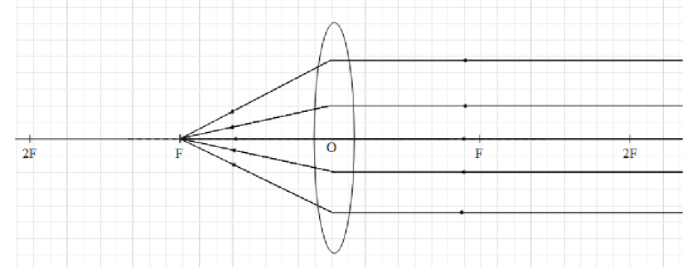
Why is a convex lens called a converging lens?
Answer
499.8k+ views
Hint:Convex lens is a spherical lens that is pointed towards the end (it is circumference) and it bulges outwards at the middle. When the rays of light coming from an object placed at infinite distance (very far) from the lens, pass through the convex lens they converge at a point after they are refracted.
Complete step by step answer:
A lens is a material of some refractive index, which helps in refracting the rays of light that pass through it. If we place an object in front of a lens, then the rays of light coming from the object refract when they pass through the lens. As a result, the original path of the light rays changes and the appear to be originating from a different point other than the position of the object.
Hence, we say that an image is formed at that point.
Convex lens is a type of lens that is pointed towards the end (it is circumference) and it bulges outwards at the middle (as shown the figure). Both the surfaces of a convex lens is spherical.
Let us understand the features or properties of a convex lens.
When the rays of light coming from an object placed at infinite distance (very far) from the lens, pass through the convex lens they converge at a point after they are refracted. As a result, the image is formed on the side of the lens.

Since a convex lens converges the lights rays passing through, at a point, it is called a converging lens.
Note:There exist another type of spherical lens called concave lens. We can say that a concave lens is opposite to a convex lens. It widens towards the end and shrinks in the middle.
When parallel light rays pass through a concave lens, they diverge in all directions and appear to be originating from a point on the side of the lens. Hence, a concave lens is called a diverging lens.
Complete step by step answer:
A lens is a material of some refractive index, which helps in refracting the rays of light that pass through it. If we place an object in front of a lens, then the rays of light coming from the object refract when they pass through the lens. As a result, the original path of the light rays changes and the appear to be originating from a different point other than the position of the object.
Hence, we say that an image is formed at that point.
Convex lens is a type of lens that is pointed towards the end (it is circumference) and it bulges outwards at the middle (as shown the figure). Both the surfaces of a convex lens is spherical.
Let us understand the features or properties of a convex lens.
When the rays of light coming from an object placed at infinite distance (very far) from the lens, pass through the convex lens they converge at a point after they are refracted. As a result, the image is formed on the side of the lens.

Since a convex lens converges the lights rays passing through, at a point, it is called a converging lens.
Note:There exist another type of spherical lens called concave lens. We can say that a concave lens is opposite to a convex lens. It widens towards the end and shrinks in the middle.
When parallel light rays pass through a concave lens, they diverge in all directions and appear to be originating from a point on the side of the lens. Hence, a concave lens is called a diverging lens.
Recently Updated Pages
Master Class 11 Economics: Engaging Questions & Answers for Success

Master Class 11 Accountancy: Engaging Questions & Answers for Success

Master Class 11 English: Engaging Questions & Answers for Success

Master Class 11 Social Science: Engaging Questions & Answers for Success

Master Class 11 Biology: Engaging Questions & Answers for Success

Master Class 11 Physics: Engaging Questions & Answers for Success

Trending doubts
1 ton equals to A 100 kg B 1000 kg C 10 kg D 10000 class 11 physics CBSE

Difference Between Prokaryotic Cells and Eukaryotic Cells

One Metric ton is equal to kg A 10000 B 1000 C 100 class 11 physics CBSE

Draw a diagram of nephron and explain its structur class 11 biology CBSE

Explain zero factorial class 11 maths CBSE

Proton was discovered by A Thomson B Rutherford C Chadwick class 11 chemistry CBSE




